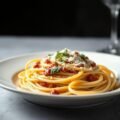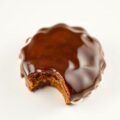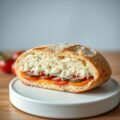Mary Berry’s Crab Linguine is a fresh, flavorful pasta dish that brings together the delicate sweetness of crab with the light, satisfying texture of linguine. Mary Berry, a renowned British chef and food writer, is well-known for her approachable yet elegant recipes, and this crab linguine is no exception. The dish combines fresh crab meat with a mixture of aromatic herbs, garlic, lemon, and a touch of cream for a luxurious yet simple pasta experience. The dish is both light and indulgent, perfect for a special occasion or a weeknight dinner.
The beauty of this recipe lies in its balance of fresh, high-quality ingredients, which highlight the sweet and tender flavor of the crab. The combination of lemon and garlic enhances the crab’s natural sweetness, while the linguine serves as the perfect vehicle for soaking up the savory, creamy sauce. Mary Berry’s approach ensures that every bite delivers a sophisticated yet comforting flavor profile.
Mary Berry’s Crab Linguine Recipe
Ingredients Needed
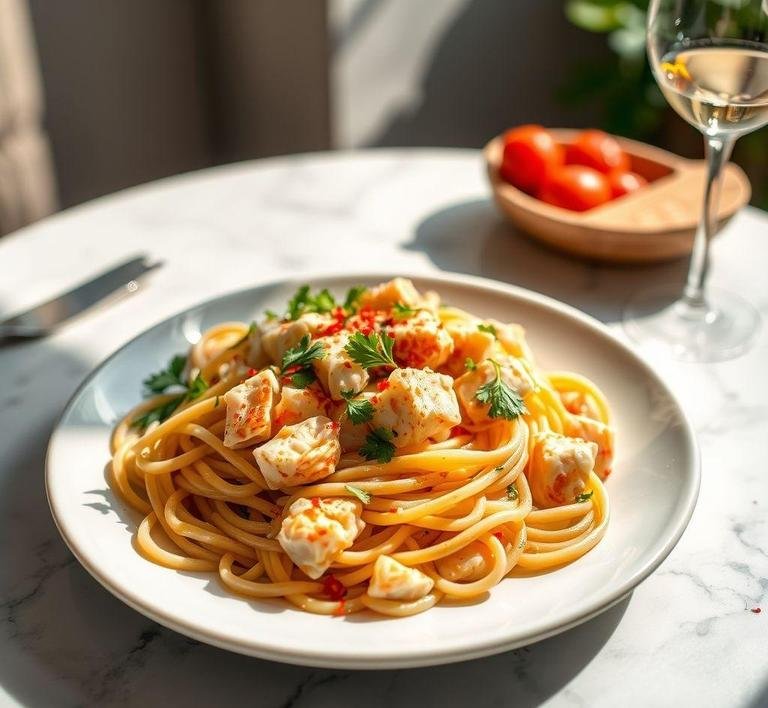
For this recipe, you’ll need a handful of fresh ingredients to make the dish vibrant and full of flavor. Here’s a detailed breakdown of the ingredients:
- Crab Meat: The star ingredient! You can use a combination of fresh white crab meat and brown crab meat for depth of flavor. White crab meat is light and sweet, while brown crab meat is richer and more intense. If fresh crab is not available, high-quality canned crab meat is a great substitute.
- Linguine Pasta: This long, thin pasta is the perfect choice for this dish. It holds the sauce well without being too heavy. You can substitute it with spaghetti if you prefer, but linguine’s slight width is ideal for this recipe.
- Garlic: A couple of cloves of garlic are finely chopped to provide that aromatic foundation of flavor that complements the crab. Garlic is the unsung hero of many dishes, infusing the sauce with depth.
- Shallots: Shallots add a gentler, sweeter onion flavor compared to regular onions, making them a great addition to this refined pasta dish.
- Lemon: Both lemon zest and juice are used in this recipe. The zest provides a fragrant citrusy punch, while the juice adds acidity and brightness to balance the richness of the crab and cream.
- Heavy Cream: This creamy ingredient helps to make the sauce silky and rich. It also enhances the natural sweetness of the crab, creating a luxurious texture that coats the pasta beautifully.
- Parsley: Fresh parsley is sprinkled over the finished dish as a garnish, providing a pop of color and a mild herbal note.
- Olive Oil and Butter: These fats are essential for sautéing the garlic and shallots, infusing them with flavor and ensuring a smooth base for the sauce.
- Salt and Black Pepper: For seasoning the dish and balancing all the flavors. Adjust to taste.
Equipment Needed
This recipe doesn’t require anything too fancy, but there are a few essential pieces of equipment to make the process smooth and efficient:
- Large Pot: To cook the linguine. You’ll want a large pot with plenty of water so the pasta can cook evenly without sticking.
- Frying Pan (or Large Skillet): This is used to sauté the garlic, shallots, and create the sauce. A heavy-bottomed pan is ideal for even heat distribution.
- Colander: For draining the pasta once it’s cooked. A colander with small holes works best for linguine, as it allows water to drain easily without losing any pasta.
- Garlic Press (Optional): If you want to make garlic prep easier, a garlic press can save time. But finely chopping garlic works just as well.
- Zester or Grater: To zest the lemon for that bright, fragrant citrus flavor.
- Wooden Spoon: For stirring the ingredients while sautéing and mixing the pasta with the sauce.
- Serving Dishes or Bowls: Finally, something to plate your beautifully finished crab linguine!
Instructions To Make Mary Berry’s Crab Linguine
Follow these steps to create a dish that is as delicious as it is visually stunning:
-
Cook the Linguine:
Bring a large pot of salted water to a boil. Add the linguine and cook according to the package instructions, usually for 9-11 minutes, or until al dente. Once done, drain the pasta, reserving a cup of pasta water for later use.
-
Prepare the Sauce:
While the pasta is cooking, heat a splash of olive oil and a tablespoon of butter in a large frying pan over medium heat. Add the finely chopped shallots and sauté for 2-3 minutes, until soft and translucent. Add the minced garlic and continue to cook for another 30 seconds, until fragrant.
-
Add the Crab:
Next, stir in the crab meat (both white and brown, if using). Gently cook for another 2 minutes, making sure not to break up the delicate crab meat too much. Add a pinch of salt and pepper to taste.
-
Create the Sauce:
Pour in the cream, zest the lemon into the pan, and then squeeze in the juice. Stir everything together to form a luscious, creamy sauce. If the sauce seems too thick, add a little reserved pasta water to thin it to your desired consistency. Let the sauce simmer gently for about 2-3 minutes.
-
Combine the Pasta and Sauce:
Add the cooked linguine directly to the pan with the crab sauce. Toss the pasta well to coat it in the creamy mixture. If needed, add more pasta water to ensure the sauce evenly coats the pasta.
-
Garnish and Serve:
Sprinkle freshly chopped parsley over the top and give it one last toss. Serve the crab linguine immediately, with extra lemon wedges on the side if you desire.
Tips And Tricks
- Use Fresh Crab if Possible: Fresh crab meat makes a significant difference in flavor, offering a sweet, delicate taste that canned crab can’t quite replicate. If using canned crab, look for premium varieties packed in water or brine.
- Don’t Overcook the Crab: Crab meat is very delicate and should be added to the sauce just long enough to heat through. Overcooking it will cause it to toughen up and lose its sweetness.
- Save Pasta Water: Always reserve a cup of pasta cooking water before draining. It’s starchy and can be used to adjust the sauce’s consistency, helping it cling to the linguine.
- Adjust Cream to Your Taste: For a lighter version, you can reduce the amount of cream or swap some of it for a splash of white wine or vegetable stock.
- Lemon is Key: The acidity from the lemon is crucial in balancing the richness of the cream and crab. Don’t skip the lemon zest-it adds an aromatic depth that elevates the dish.
- Make it Spicy: If you love a little heat, you can add a pinch of red pepper flakes when sautéing the garlic. It gives the dish a mild kick that complements the sweetness of the crab.
Mary Berry’s Crab Linguine is a delightful combination of simplicity and sophistication, making it the perfect dish for any occasion. It brings together fresh crab, creamy sauce, and fragrant herbs to create a meal that’s both comforting and refined. With just a handful of ingredients and a few easy steps, you can create a dish that feels elegant yet accessible, embodying the essence of Mary Berry’s cooking style. Whether you’re cooking for a special dinner or a casual evening with loved ones, this dish is sure to impress with its bright, savory flavors and luxurious texture. Enjoy!
Easy Recipe Variations For Mary Berry’s Crab Linguine
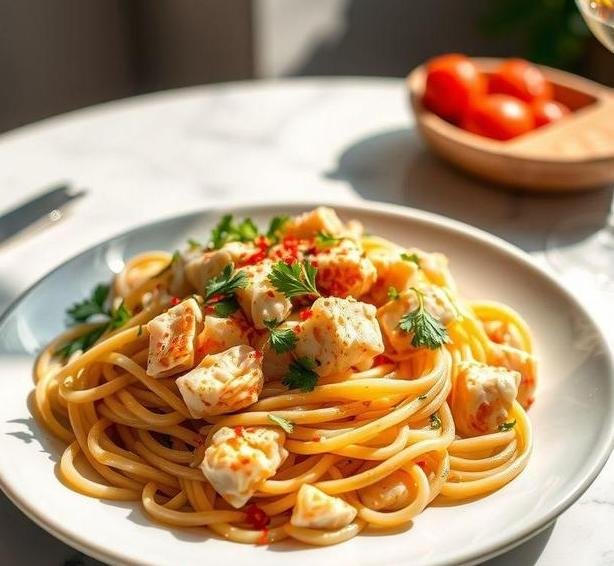
Mary Berry’s Crab Linguine is already a delicious and sophisticated dish, but the beauty of it lies in its versatility. You can experiment with various ingredients and techniques to suit your tastes, dietary needs, or even just to shake things up a little. Here are some simple yet impactful variations that can elevate this dish or give it a new twist:
1. Adding A Kick With Chilli And Garlic
For those who enjoy a little heat in their seafood dishes, adding a finely chopped red chilli or a pinch of dried chilli flakes can bring an exciting level of spice to the Crab Linguine. The fiery warmth of the chilli complements the sweet, delicate taste of the crab perfectly. Pair this with extra garlic for an aromatic, savory boost that will transport your taste buds straight to the Mediterranean.
2. Make It Creamier With A Dash Of Cream Or Mascarpone
If you prefer a more indulgent version, try stirring in some double cream or mascarpone cheese towards the end of cooking. This will give the linguine a luscious, velvety texture and enhance the richness of the crab. For an extra tang, you can also add a squeeze of lemon juice or zest to balance out the creaminess.
3. Vegetarian Twist With Courgettes Or Spinach
For a lighter, vegetarian alternative, consider substituting the crab with courgette ribbons (zucchini) or sautéed spinach. Courgettes, when sliced thinly or julienned, can mimic the texture of crab, providing a fresh and crunchy element to the linguine. Spinach, on the other hand, will contribute a mild, earthy flavor that pairs beautifully with garlic and olive oil.
4. Herbal Infusion With Fresh Basil Or Tarragon
Experimenting with fresh herbs can totally alter the profile of your crab linguine. Basil, with its bright, slightly sweet flavor, can add a refreshing lift to the dish, especially if you toss it in just before serving. Tarragon, on the other hand, with its aniseed-like taste, pairs especially well with seafood and adds a sophisticated touch to the linguine.
5. Adding Roasted Vegetables For More Texture
For a heartier version, roasted vegetables such as cherry tomatoes, bell peppers, or even a handful of roasted asparagus could make the dish more substantial. These vegetables, caramelized from roasting, add sweetness and a slight smoky flavor, which enhances the delicate crab and creates a balance of textures.
6. Switching Crab Types For Different Flavours
While Mary Berry’s recipe likely calls for fresh crab, you can easily swap this for a different type of seafood. Lobster or langoustine could be used for a luxurious variation, while smoked salmon or prawns can create a whole new profile. Smoked salmon, in particular, adds an element of richness that contrasts nicely with the lightness of the linguine.
Storing Leftovers
If you find yourself with leftovers from your delicious crab linguine, no need to worry – you can preserve the dish for later, so you don’t miss out on the mouthwatering flavors! Proper storage ensures the dish remains fresh and tasty when reheated.
1. Cool And Store Quickly
To keep your leftover crab linguine at its best, it’s important to cool it down promptly. Allow the pasta to come to room temperature, but don’t leave it out for more than two hours. After that, refrigerate it in an airtight container. Be sure to remove any extra sauce or garnishes like herbs that might not keep well over time.
2. Refrigeration
Your crab linguine will keep well in the fridge for up to 2 days. The delicate nature of the crab means it’s best eaten sooner rather than later. When you store it, make sure it’s sealed tightly to prevent air from drying out the pasta or crab. Adding a small bit of olive oil on top before sealing can also help prevent the pasta from sticking together.
3. Freezing For Long-Term Storage
While pasta dishes in general aren’t always ideal for freezing due to the potential for texture changes, it can still work if you’re in a pinch. To freeze crab linguine, place the cooled dish in a freezer-safe container, ideally in individual portions, and wrap it tightly in plastic wrap or aluminum foil. It can last for up to 1-2 months in the freezer. To reheat, thaw it overnight in the fridge and then warm gently in a pan with a splash of stock or cream to prevent it from drying out.
4. Reheating
When reheating, whether in a microwave or on the stovetop, be careful not to overcook the dish. Reheat it slowly over low heat to avoid toughening the crab and making the linguine too soft. Stirring occasionally and adding a bit of extra cream or butter can help restore some of the richness that may have been lost during storage.
What To Eat With Mary Berry’s Crab Linguine?
Mary Berry’s Crab Linguine is a flavorful and satisfying dish on its own, but it can be complemented by a few side dishes and accompaniments that bring balance to the meal, making it even more enjoyable.
1. A Fresh Green Salad
A simple, crisp green salad is a perfect companion to this seafood pasta. The freshness of lettuce, arugula, or mixed greens, dressed with a light vinaigrette, can provide a bright contrast to the rich flavors of the linguine. A squeeze of lemon juice over the salad can tie everything together with a refreshing zing that echoes the acidity in the linguine.
2. Garlic Bread
Garlic bread, with its crunchy texture and buttery, garlicky flavor, is a fantastic side to serve with Mary Berry’s Crab Linguine. The garlic enhances the flavors in the pasta, while the bread provides a hearty and satisfying texture. It’s also a great way to soak up any extra sauce left on the plate!
3. Roasted Vegetables
As mentioned earlier, adding roasted vegetables such as bell peppers, zucchini, or even roasted fennel can pair beautifully with the crab linguine. These vegetables add a sweetness and smoky flavor that complements the delicate crab without overwhelming the dish.
4. White Wine
No seafood pasta is complete without a glass of wine. A crisp, dry white wine, such as Sauvignon Blanc or Pinot Grigio, can cut through the richness of the crab and provide a nice, refreshing balance. If you’re serving the linguine for a special occasion, a glass of Champagne or Prosecco can bring some festive effervescence to the meal.
5. Lemon And Herb Focaccia
A warm slice of lemon and herb focaccia can be a delightful side dish. The slight citrus notes in the focaccia will play nicely with the crab’s sweetness, while the herbs will tie in with the seasonings in the linguine. It’s also perfect for mopping up any sauce left on your plate.
Conclusion
Mary Berry’s Crab Linguine is a dish that combines simplicity and elegance, making it perfect for both everyday meals and special occasions. Its versatility means you can adjust it according to your taste preferences, dietary restrictions, or seasonal ingredients, all while keeping the core flavors intact. Whether you’re adding a bit of spice with chilli, making it creamier with mascarpone, or going for a more vegetarian-friendly version with courgettes, the options are endless.
Storing leftovers is easy, as long as you follow proper guidelines to preserve both flavor and texture, and pairing it with sides like fresh salads, garlic bread, or roasted vegetables can elevate the dish even further. With so many possibilities for customizing and pairing, Mary Berry’s Crab Linguine remains a timeless recipe that can be enjoyed in a variety of ways. Whether served for a weeknight dinner or a festive gathering, this dish will surely satisfy any craving for a delicious, seafood-inspired meal.
FAQs
What Are The Main Ingredients In Mary Berry’s Crab Linguine Recipe?
The main ingredients for Mary Berry’s crab linguine recipe include fresh crab meat (usually white and brown crab meat), linguine pasta, garlic, olive oil, lemon, fresh parsley, chili flakes, and a touch of white wine. The recipe also calls for a little cream to add richness and flavor to the sauce.
Can I Substitute Crab With Other Seafood In Mary Berry’s Linguine Recipe?
Yes, you can substitute crab with other seafood options in Mary Berry’s crab linguine recipe. Popular alternatives include lobster, prawns, or scallops, depending on your preferences. However, crab provides a sweet and delicate flavor that’s hard to replicate exactly, so the taste may vary slightly with substitutions.
How Do I Ensure The Pasta Doesn’t Become Soggy In Mary Berry’s Crab Linguine Recipe?
To prevent the pasta from becoming soggy, it’s important to cook the linguine al dente, or slightly firm, following the instructions on the pasta package. Also, remember to reserve some pasta cooking water before draining it. This starchy water can be added to the sauce to help it coat the pasta and ensure a smooth consistency. Finally, add the crab meat and sauce mixture to the pasta just before serving to maintain the perfect texture.
